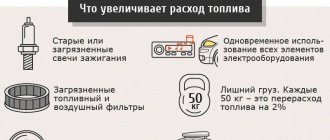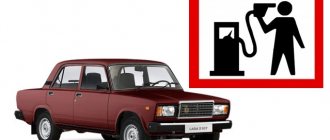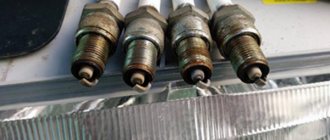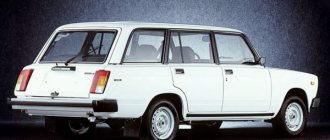The fuel consumption of the VAZ 2107 per 100 km depends on many factors. These include the following: vehicle speed, engine type and fuel supply system. What is the fuel consumption of a VAZ 2107 with a carburetor? According to documents for this model of car, the average fuel consumption on the highway is 6.8 liters, if the speed is about 90 km/h. P When driving in city mode, this figure increases significantly - up to 9.6 liters.
What you need to know to reduce fuel consumption
Checking the air damper in the carburetor
Higher fuel consumption on a VAZ 2107 with a carburetor engine occurs if the air damper is not fully open. What is its correct position? Surely, an experienced driver knows that when the engine in the car is running, the choke in the carburetor must be in a vertical position. The choke handle must be fully extended towards you. Fuel consumption at idle speed in the VAZ 2107 can be reduced by specially setting the carburetor air damper to some extent. But such manipulation is not effective enough.
| Engine | Consumption (highway) | Consumption (city) | Consumption (mixed cycle) |
| 1.3 l 4-mech (gasoline) | 7.8 l/100 km | 11.5 l/100 km | 10.5 l/100 km |
| 1.4 l 5-mech (gasoline) | — | 9 l/100 km | — |
| 1.5 l 5-mech (gasoline) | 5.2 l/100 km | 8.9 l/100 km | 7 l/100 km |
| 1.6 l 5-mech (gasoline) | — | 8.5 l/100 km | — |
| 1.3 l 5-mech (gasoline) | 9.5 l/100 km | 12.5 l/100 km | 11 l/100 km |
The reasons for the high fuel consumption on VAZ 2107, the carburetor of which is in a faulty condition, speak for themselves. Young drivers do not always take the time to thoroughly check their car, and this can lead to negative consequences. Other factors of uneconomical fuel consumption may include:
- incorrect speedometer readings;
- malfunction of the device that measures the level of gasoline in the tank;
- driver's driving style.
Statistics
The fuel consumption of a Lada 2107 with an injection engine is perfectly shown by statistics provided by the manufacturer and figures received from car enthusiasts.
The manufacturer claims that when driving on the highway, the car will normally consume 9 liters of gasoline, but in reality we see that consumption does not exceed 7.75 liters.
Driving in urban conditions should consume only 9.70 liters, but here the figure exceeds 10.25 liters. With a mixed type of driving, the readings from the manufacturer and the car enthusiast practically coincided, the former had a consumption of 8.50 liters, and the latter - from 8.82 liters. However, we see that in practice the consumption is higher.
The passport does not indicate how much gasoline is consumed when driving off-road. Having checked it ourselves, we see that such driving requires more than 9 liters of fuel.
Checking the fuel jet
Also, the reason for the high consumption of gasoline on a VAZ can be the fuel nozzle if its holder is not tightly enclosed. Because of this, during different engine operating modes, much more fuel enters the cylinders than required by the norm. To avoid this situation, check the tightness of the holder. You cannot tighten it too much, but even if it is not tightened completely, this will lead to the fact that the holder can randomly turn out while the machine engine is running. The reason for the overconsumption is that the diameter of the jets is too large or they are dirty.
Logbook VAZ 21074 (2007)
Operation: Gasoline consumption in winter
Conducted an analysis of gasoline costs since January. I got a consumption of 10 l/100 km. At first I thought a lot. Then I thought: Warm up in the morning for at least 10 minutes, and in the evening (after work) 10 minutes. Plus, a signal with auto start is installed, that is, at temperatures below -18 degrees, it will still start for 10 minutes. The colder it is, the more starts there are per day, and on weekends you sometimes don’t go out, and at temperatures around -30, the car starts on average 5-6 times per day (again, 10 minutes each). I remembered about the fuel write-off standards of the Ministry of Transport of the Russian Federation. There, to warm up the interior and engine in winter, there is an increase of up to 30% on the base consumption, so I think that this is quite normal consumption for Siberia in winter.
- More about this car:
- Logbook
- Breakdowns
- Parting
- tires ROSAVA SQ-201
- A little about fuel consumption.
- A leak began to leak into the passenger compartment on the passenger side... 56531 km
- The cigarette lighter and radio did not work. … 56400 km
- The clutch began to slip. 1st and 2nd gear n... 55000 km
Excellent consumption. On my carburetor VAZ 2106 in winter it turned out to be 12 somewhere, and I considered that to be normal for such a car.
I remember that the winter premium is 10 percent.
Why start it below 18? And on weekends, when it’s not in use, what’s the point of starting it. Cold starts mean both gas consumption and increased wear.
Up to minus 30, if it is in good working order and the correct oil, it will start, but if it is needed at lower temperatures, then autostart may be required.
I consider autostart at -18 (according to engine temperature) a good thing: firstly, if in severe frost there is a need for an unplanned trip, then, as they say, the car will be steaming, and secondly, periodic warming up prevents the battery from freezing (which has recently do not differ in quality). Thus, adding both arguments we get - there is less likelihood of dancing around the car in the Siberian winter if it is necessary to operate it.
I wonder what was the method for calculating gasoline consumption, according to the trip computer readings or something else? And it seems to me that the result turned out to be too optimistic. You know, over the whole winter, the frosts lasted only a few days and the temperature dropped to -5. (It’s just terrible!) So of course I never warm up the engine, I started it and immediately hit the road, and that turns out to be more than 11 liters (car Kalina-2. 1.6 engine / 8V) though only due to city traffic jams. By the way, I now have two trip computers on my car. one is native, the other is State. and the difference in their readings for fuel consumption (average) is approximately a liter. More attractive figures were given by the State. I thought at first. that the truth is somewhere in the middle. But it turns out not. To find out the truth, I decided to use the old grandfather’s method. I poured gasoline into the tank up to the cap. then I reset the daily mileage counter and both computers, drove 80 kilometers, then added gasoline from a measuring cup to the tank again until the plug, made some simple calculations and it turned out. that both “companies” are lying, especially the State’s blatantly, because the real figure was more than the readings of the native one by about 0.3 liters, and the State’s by as much as 1.4 liters/100 km.
Excessive fuel consumption on the injector
Owners of new modified VAZ cars with a single electronic control unit may encounter excessive consumption of gasoline at the injector. One of the reasons may be incorrect pressure in the fuel system. Recheck the car's engine management system; there may be a malfunction in its operation.
Also, one of the key problems with fuel consumption can be the failure of an injector or temperature or oxygen sensor. The fuel consumption of a Lada 2107 per 100 km with an injector (engine volume 1.5 liters) in the city in winter should be 9.5-13 liters, and in summer – 7.5-8.5 liters.
What can you say about an injection engine?
As soon as the international Euro 2 standards were adopted in Russia, the production of carburetor sevens ceased. The manufacturer gradually mastered the production of internal combustion engines with distributed fuel injection. This made it possible to change the technical characteristics of the vehicle for the better, make engine operation more stable, and also reduce the permissible consumption of high-octane fuel.
This should have meant that the car had become more economical to operate compared to its predecessors. However, during further operation, a number of drivers noticed an increase in consumption. This became especially acute when driving within a busy city. It is not surprising that car enthusiasts have begun to think more and more about how to reduce excessively high gas mileage on “Sevens”.
What needs to be done to optimize fuel consumption
Try to drive without sudden braking or sudden acceleration. To ensure that the actual consumption of the VAZ 2107 does not exceed the norm, replace the use of mineral motor oil with synthetic one.
Check your vehicle regularly and replace the air filter if necessary.
Gasoline consumption 2107 per 100 km (and regardless of the kilometers traveled) at normal vehicle speed also depends on the quality of the fuel, so try to purchase it at large network gas stations. The saving of fuel and your financial resources depends on the technical condition of the car.
Fuel consumption: questionable reduction techniques
Today, folk “craftsmen” recommend a wide range of anti-devices and tips that supposedly guarantee significant gasoline savings.
Popular and promoted means include:
• magnetic activators; • fuel additives; • cheap type of gasoline.
Before spending money on such devices and expecting some kind of exorbitant savings on fuel, you need to remember the school course in physics and chemistry, namely, that magnetic fields do not in any way affect the combustion procedure of gasoline. These are completely different processes and are in no way connected with each other. The only advantage of magical magnetic activators is their harmlessness.
Magnetic activators
Another thing is fuel additives. Not only are they unable to increase the efficiency of the motor to the desired values (if it were true, such a device would have been patented long ago, and its most active consumers would have been the aviation and cargo transportation industries), they are simply dangerous to the life of the driver, since are capable of damaging the entire fuel system or, even worse, disrupting the operation of the engine while on the move.
The palm goes to the anti-advice, which may interest a car owner right now - this is the use of cheap types of gasoline instead of expensive ones or those recommended by the manufacturer. The pursuit of fuel economy savings can turn into a disaster, because low-octane gasoline will not only greatly increase fuel production, but will also actively accelerate engine wear.
Electric fuel pump
But this is a device that is responsible for ensuring that the required pressure is always present in the ramp. How to reduce fuel consumption will be discussed below. But it is worth noting that the electric pump does not affect this parameter. It is located directly in the tank, combined in a single housing with a gasoline level sensor. It also has a filter. People call it “diaper” due to its external resemblance.
By the way, try to change it as often as possible, otherwise the fuel lines and injectors will become clogged. And cleaning sometimes costs a lot of money. In addition to the electric pump, there is another device that allows you to maintain constant pressure - the regulator on the ramp. With its help, excess gasoline is discharged back into the tank. Therefore, excess pressure for the system is not dangerous.
Questionable fuel saving methods
Sometimes motorists give advice on how you can save on RT, but not all the proposed methods work, and often savings in such ways turn out to be dubious.
- Reducing the number of idle speeds. It should be noted that idling is far from the most economical mode, and if you measure the CO level with a gas analyzer, then at idle the device will show the emission of harmful impurities in the exhaust gases no less than at medium speeds. In addition, when the idle speed is reduced from 800-900 rpm to 500-600, there is a possibility that the engine will constantly stall when the gas is released.
- Magnetic activators. On the Internet you can still find advertisements for “miracle” remedies that supposedly reduce fuel consumption when used. The “magic” device only needs to be attached to the fuel line, and the RT will immediately decrease by 20-30%. At the same time, sellers advise not to accelerate sharply or drive at high speeds. In a word, all these activators are pure deception, luring money out of customers’ pockets.
- The car is coasting. You can get advice from car enthusiasts - when descending from a mountain, engage neutral gear, and in this case the load is reduced, and a lower RT is obtained. It is worth noting that this driving style is unsafe - if the engine stalls, the vacuum brake booster will stop working, braking efficiency will noticeably decrease, which can lead to an emergency.
- To save money, you need to fill with cheaper gasoline. Such savings are very doubtful. Firstly, the car drives worse on gasoline fuel with a low octane number, and the engine itself may suffer from the quality of the fuel. Secondly, with bad gasoline the fuel consumption becomes higher than with good gasoline, and the difference in the price of fuel in this case is reduced to zero.
- Adding additives to gasoline. You need to know that manufacturers already add all the necessary fuel additives to the fuel, and all unnecessary additives can only harm the car engine. Experiments with additives can lead to major engine overhauls.
Why is an injector better or worse than a carburetor?
Convenience is the main trump card of the injection system. In addition, its minimum fuel consumption is much lower than that of a carburetor. The reason for this is a more advanced system, control of all engine operating parameters. There are also advantages - there is no suction. The air supply is handled by an electronic system. At high speeds, the engine response is higher.
But at low speeds, unfortunately, the torque and power are lower. A very complex design entails expensive maintenance. Without diagnostics, it is sometimes difficult to determine the cause of a car breakdown. Even all this data is enough to try to answer the question of which is better - an injector or a carburetor. But there will still be no final answer. On the one hand, the injector is better. On the other hand, it turns out to be somewhat worse.
Reasons not related to the carburetor
Engine malfunctions
Watch and listen to how your car's engine works. The presence of black or bluish smoke, rattling sounds are signs of a problem. In order to figure out what is wrong with the engine, it is worth measuring the compression in the engine cylinders. It is recommended to carry out this operation even if you are satisfied with the engine performance, but the fuel consumption is not. To do this you will need a device - a compression meter.
Compressometer
To obtain correct results, compression is measured on a warm engine. Unscrew all spark plugs. The contact of the central wire of the distributor is placed at a distance of 1-2 cm from the ground. The compression meter is pressed against the spark plug hole, and an assistant, fully pressing the gas pedal, turns the engine with the starter; 3-4 seconds is enough to get results. The operation is performed for each cylinder and the results are recorded. The permissible difference in pressure between the cylinders should not exceed 1 kg/cm². And the compression in each cylinder must be at least 9.7 kg/cm². If the readings are not within the normal range, this indicates an engine malfunction; it is necessary to understand the reasons, and repairs may be required. You should not rely on the efficiency of a faulty engine.
Violation of engine thermal conditions
Temperature sensor VAZ 2107
The operating temperature of the VAZ 2107 engine is 80-90 degrees. If the thermostat of the cooling system is constantly open, the liquid will move around a large cooling circle, and this in turn will lead to incomplete warming up of the engine, loss of power and increased fuel consumption. And the opposite situation occurs: when the engine overheats, the filling of the cylinders with the fuel mixture is disrupted, which leads to loss of power and increased fuel consumption.
Incorrect ignition timing setting
It is not for nothing that the manufacturer indicates the recommended ignition timing (IAF) in the car manual, since it ensures that the engine operates in optimal mode. Deviations of the OZ in one direction or another will lead to an increase in fuel consumption. For VAZ 2107, the SOP should be 5° for AI-92 gasoline. But it should be noted that the best way to set the ignition timing is on the road. The engine warms up to operating temperature. The car accelerates to 50 km/h, and in the last direct gear the gas pedal is sharply pressed. You should hear a detonation sound (tapping of fingers) that ends after a few seconds. If the detonation is prolonged, the ignition is too early; if there is no detonation, the ignition is too late. The SOP is adjusted by rotating the distributor.
Distributor VAZ 2107
Damaged or leaking connections in the fuel line
Fuel leak
Everything is simple here, if the tightness of the tank, hoses, loose clamps of various connections is broken, fuel may leak. Having placed the car in the inspection hole and started the engine, you must carefully inspect the entire length of the fuel line for leaks, including under the hood. For convenience, it is advisable to remove the air filter. If necessary, tighten the clamps, change the hoses or gaskets.
Incomplete release of the car wheels
A very common situation. Braking a wheel or wheels creates resistance to vehicle movement and, of course, increases fuel consumption. The probable reason for this situation is the lack of free play of the brake pedal, that is, the wheels are constantly in a state of slight braking. On the VAZ 2107 the free play is 3-5 mm. adjustable by moving the brake light switch.
Brake pedal VAZ 2107
A seized caliper piston could also be a possible cause. We pay attention to the brake discs; with constant contact, dark marks from the pads remain on them, and the car disc can become very hot. Check to see if the handbrake cable is overtightened.
Wheel bearings overtightened
If the hub nuts are tightened too much, additional resistance will be created to the vehicle's movement, which will affect fuel consumption.
Insufficient tire pressure, tire wear
Both on the VAZ 2107 carburetor and on other cars, high fuel consumption can be caused due to low tire pressure. It must be monitored once a week and before each long trip. Low tire pressure prevents the car from rolling. You can check the pressure with a pressure gauge.
Pressure gauge
Violation of wheel alignment angles
Incorrect angles of the front wheels of the VAZ 2107 not only create additional resistance to movement and increase consumption, but also lead to increased tire wear. Work on checking and setting the wheel angles of the car is carried out after each replacement or repair of suspension parts. This operation is also carried out after strong impacts due to careless driving.
Defective spark plugs
They lead to interruptions in engine operation, loss of power, and increase fuel consumption.
Malfunction of the vacuum ignition timing regulator
It will cause an incorrect shift in the ignition timing at different engine operating modes, this will lead to a loss of power, throttle response and, as a consequence, increased gasoline consumption.
Vacuum corrector VAZ 2107
Improper adjustment of the clutch drive, or its malfunction
With such a problem with the car, slippage occurs, difficulty accelerating the car, which inevitably leads to excessive gas, which will significantly increase the appetite of your vehicle.
Driving style
High fuel consumption of a VAZ 2107 carburetor may be a consequence of a driving style that can quite significantly affect fuel consumption. It’s one thing when you are calmly driving a car and quite another when you are trying to squeeze out of the engine everything that it is capable of using the gas pedal. An aggressive driving style increases fuel consumption.
Vehicle overload
Everything is logical here. More weight means more load means higher consumption.
Fuel quality
When refueling with low-quality fuel, you will have to press the gas pedal harder, and this will lead to an increase in fuel consumption. Low-quality fuel can have a detrimental effect on a car's engine, so be careful what you put into the tank.
Air filter dirty
Dirty air filter
The composition of the fuel mixture formed by the carburetor greatly depends on the amount of incoming air. When the air filter is dirty, the air flows worse, the engine loses power, we use the gas pedal more actively, and consumption increases.
General design of the injection system
The first direct injection systems appeared several decades ago. They made it possible not only to reduce the basic fuel consumption of cars, but also to significantly simplify driving. True, the complexity of the design has increased - many sensors and actuators have appeared that are not inherent in carburetors. The introduction of such systems became possible only thanks to the development of microelectronics. Because it is based on a control unit that analyzes thousands of signals every second.
Just think about how many pulses the sensor alone produces? Hundreds per second, which is a lot. In addition, they all need to be analyzed and responded to correctly. But if carburetors operate solely on the basis of simple physical processes, such as the pressure difference in the chambers, then the injector functions only thanks to electronic devices. Pressure is created not due to vacuum in the ramp, but by pumping fuel and air into it. This will be discussed a little below, and the question of which is better – an injector or a carburetor on a car of the seventh model – will also be considered.
Causes related to the carburetor
Carburetor choke is not fully open
After the engine has warmed up, the choke handle should be recessed and the carburetor air damper should be fully open. The engine is warmed up using an enriched mixture, for which purpose the air damper is closed with the choke handle. If the damper is constantly closed, the fuel mixture is over-enriched, and this leads to an increase in the car’s appetite. The choke handle is recessed and the position of the air damper is checked. If it is not fully open, there is a malfunction; it is necessary to adjust the choke drive, or eliminate the jamming of the damper.
Air damper carburetor VAZ 2107
Idle air fuel nozzle holder or solenoid valve is loose
Valve XX VAZ 2107
Fuel enters the idle system through the nozzle; if it is not screwed in completely, additional fuel will bypass the nozzle, enriching the mixture. The idle system operates in all engine modes. And every time we press the gas pedal, we force the engine to suck in an extra portion of fuel, leading to excessive fuel consumption.
Float chamber needle valve leaking
Needle valve VAZ 2107
A working needle valve of the float mechanism should shut off the flow of fuel into the carburetor at a certain level necessary for normal engine operation. If this level is exceeded, the fuel mixture entering the engine will be over-rich. If the fuel valve does not cope with its task, the fuel level in the float chamber will increase, and with it the fuel consumption will increase. This may happen due to a trapped speck or a valve malfunction. Moreover, the flow of additional fuel into the float chamber may be insignificant and unnoticeable, but fuel consumption will increase by a liter or one and a half. Therefore, it is worth checking the functionality of the shut-off needle valve or replacing it with a known good one.
Larger diameter main metering system or idle system fuel jets installed
With an increased diameter of the fuel jets, the mixture entering the engine becomes richer. Therefore, it is necessary to check that the size of the installed jets corresponds to the calibration data established by the manufacturer according to the vehicle manual.
The air jets of the main metering system or the idle system are clogged
GDS jets VAZ 2107
Clogged air jets will result in a richer mixture formed by the carburetor. It is necessary to clean and blow out the jets.
System XX carburetor VAZ 2107
To clean the jets, it is necessary to use softer materials than the jet material, so as not to damage the latter (for example, copper wire).
The forced idle economizer system is faulty
EPHH is designed to cut off the fuel supply while the car is moving with the gas pedal released and the gear engaged; it is also called engine braking mode or forced idle. If the system is faulty, when the engine brakes, fuel will be actively sucked through the idle system, no savings will be achieved, and overall gasoline consumption will increase.
EPHH VAZ 2107
The idle speed economizer valve of the VAZ 2107 may not close the outlet at idle for the following reasons: - malfunction of the pneumatic valve control unit; — pneumatic valve malfunction; — malfunction of the microswitch or violation of its installation; — malfunction of the idle speed economizer.
Coordination of the microcontroller with sensors
Therefore, some signals need to be amplified and others reduced. For these purposes, intermediate stages (matching devices) are used - operational amplifiers and voltage dividers. This is all clear, but the microprocessor will not be able to turn on even the winding of the electromagnetic relay. For this purpose, special Darlington assemblies are used. This is a small microcircuit; it is based on amplifier stages based on field-effect transistors. They operate in key mode and allow switching currents up to 30 A. This is quite enough to power the winding of an electromagnetic injector.
It is impossible to coordinate the microcontroller with the injectors using an electromagnetic relay. The reason for this is the high pulse frequency. The relay simply will not be able to manage the required number of switchings per second. From this point of view, the switch on the field-effect transistor turns out to be much more efficient.











